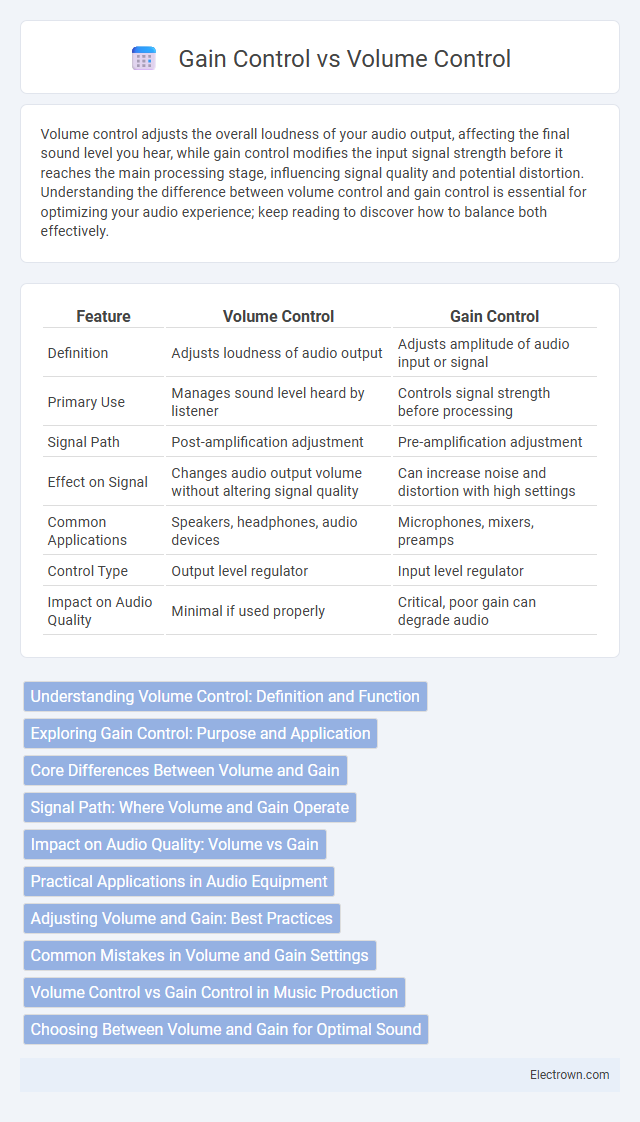Volume control adjusts the overall loudness of your audio output, affecting the final sound level you hear, while gain control modifies the input signal strength before it reaches the main processing stage, influencing signal quality and potential distortion. Understanding the difference between volume control and gain control is essential for optimizing your audio experience; keep reading to discover how to balance both effectively.
Table of Comparison
| Feature | Volume Control | Gain Control |
|---|---|---|
| Definition | Adjusts loudness of audio output | Adjusts amplitude of audio input or signal |
| Primary Use | Manages sound level heard by listener | Controls signal strength before processing |
| Signal Path | Post-amplification adjustment | Pre-amplification adjustment |
| Effect on Signal | Changes audio output volume without altering signal quality | Can increase noise and distortion with high settings |
| Common Applications | Speakers, headphones, audio devices | Microphones, mixers, preamps |
| Control Type | Output level regulator | Input level regulator |
| Impact on Audio Quality | Minimal if used properly | Critical, poor gain can degrade audio |
Understanding Volume Control: Definition and Function
Volume control adjusts the amplitude of an audio signal's output, directly influencing the loudness heard through speakers or headphones. It operates by modifying the signal level after amplification, ensuring user-friendly regulation of sound intensity without altering the original tonal quality. This function is critical in audio systems for maintaining audio clarity and preventing distortion during playback.
Exploring Gain Control: Purpose and Application
Gain control adjusts the amplitude of an audio signal before it reaches the main processing stage, optimizing the input level to prevent distortion and maintain signal clarity. It is crucial in settings like audio recording, live sound, and broadcasting, where adjusting the gain ensures clean and balanced audio capture. Understanding gain control helps you achieve precise sound quality by managing the initial signal strength effectively.
Core Differences Between Volume and Gain
Volume control adjusts the overall loudness of an audio signal after amplification, affecting the output level heard through speakers or headphones. Gain control modifies the input signal strength before amplification, influencing the signal-to-noise ratio and quality of the audio. Proper management of gain ensures clean sound without distortion, while volume control tailors the listening level to the environment.
Signal Path: Where Volume and Gain Operate
Volume control adjusts the signal level after it has passed through the preamp stage, affecting the overall loudness delivered to your speakers or headphones. Gain control operates at the input stage, amplifying the initial signal strength before any tonal shaping or effects are applied. Understanding the distinct signal path positions of volume and gain helps optimize sound quality and prevent unwanted distortion in your audio setup.
Impact on Audio Quality: Volume vs Gain
Volume control adjusts the output level of the audio signal without altering its original tone or signal-to-noise ratio, preserving audio quality. Gain control changes the strength of the input signal before processing, which can introduce distortion or noise if set too high, affecting clarity and fidelity. Optimizing gain settings ensures a clean signal, while volume control manages listening levels without degrading sound integrity.
Practical Applications in Audio Equipment
Volume control adjusts the overall loudness output of audio equipment, allowing users to set their preferred listening level without altering the audio signal's quality. Gain control, often found on preamplifiers and mixers, regulates the input signal strength to optimize audio clarity and prevent distortion during recording or live sound reinforcement. Understanding the practical applications of volume and gain control helps you achieve precise sound balancing and improved audio performance in devices like amplifiers, headphones, and mixing consoles.
Adjusting Volume and Gain: Best Practices
Adjusting volume control changes the overall loudness of the audio signal reaching your speakers or headphones, while gain control modifies the input level of the audio signal, affecting its strength before processing. Best practices for adjusting volume and gain involve setting the gain to an optimal level that maximizes signal clarity without causing distortion, then using the volume control to fine-tune listening levels. Properly balancing gain and volume ensures clear sound quality and protects your audio equipment from damage.
Common Mistakes in Volume and Gain Settings
Common mistakes in volume and gain settings include setting the gain too high, which causes signal distortion and clipping, or setting it too low, resulting in weak audio signals with excessive noise. Confusing volume control with gain leads to improper audio levels, as volume adjusts output loudness while gain controls input signal strength. Properly balancing gain and volume ensures clear sound quality and prevents equipment damage or feedback issues.
Volume Control vs Gain Control in Music Production
Volume control adjusts the overall loudness of your audio output, shaping the final sound level in a mix, while gain control regulates the input signal strength to prevent distortion and maintain clarity during recording or processing. In music production, proper use of gain ensures clean, distortion-free tracks, whereas volume control balances different elements within the mix for desired dynamics. Mastery of both controls is essential for achieving professional-sounding recordings and mixes.
Choosing Between Volume and Gain for Optimal Sound
Choosing between volume control and gain control depends on your desired audio outcome and system configuration. Gain control adjusts the input signal strength, affecting the pre-amplification stage and potentially introducing distortion if set too high, while volume control manages the output loudness without altering signal quality. Understanding Your audio setup ensures optimal sound by using gain to shape signal clarity and volume to balance listening levels effectively.
Volume Control vs Gain Control Infographic

 electrown.com
electrown.com